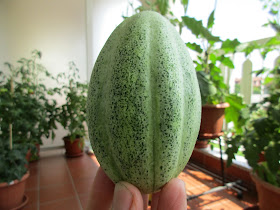Lo scorso inverno ho ricevuto dei semi di pomodori originari della Campania, tutte piante a crescita determinata. Per primo il Cannellino Flegreo, coltivato su terreni vulcanici sabbiosi della zona campano-flegrea fin dalla fine dell'Ottocento. È una di quelle varietà antiche dimenticate che i coltivatori campani stanno cercando di recuperare. Ha un sapore piuttosto dolce. È particolarmente adatto per la produzione di conserve; anche in insalata fa la sua figura anche se la buccia è un po' dura. Pesa intorno ai 15-20 grammi.
 |
| (1) Pomodoro Cannellino Flegreo - pianta |
 |
| (2) Pomodoro Cannellino Flegreo |
 |
| (3) Pomodoro Cannellino Flegreo |
 |
| (4) Pomodoro Cannellino Flegreo |
Un'altra varietà antica che sta tornando in auge in Campania è il Fiaschello Battipagliese. È stato coltivato nella Piana di Battipaglia e del Sele dal 1900 al 1970; poi se ne sono perse le tracce, tranne in qualche orto di contadini del posto. È al centro di un'intensa attività di recupero e valorizzazione dal 2013. Anche questo pomodoro è adatto per le conserve per la sua polpa particolarmente polposa. Ha un sapore piuttosto dolce, come il Cannellino Flegreo; i frutti sono più grossi e la pianta ha lo stesso sviluppo determinato alto.
 |
| (5) Pomodoro Fiaschello Battipagliese |
 |
| (6) Pomodoro Fiaschello Battipagliese |
 |
| (7) Pomodoro Fiaschello Battipagliese |
 |
| (8) Pomodoro Fiaschello Battipagliese |
Un'altra pianta di pomodoro a crescita determinata, ma bassa questa volta: il Vesuvio. A dire il vero, non sono sicuro che questo sia il suo nome. Potrebbe essere un ibrido. Chissà se Claudia, che mia ha regalato i semi, si ricorda la sua storia.
 |
| (9) Pomodoro Vesuvio |
Pianta bassa, ma carica di frutti, nemmeno tanti piccoli.
 |
| (10) Pomodoro Vesuvio |
 |
| (11) Pomodoro Vesuvio |
Ha polpa spessa, polposa e un po' acidula, adatta per le conserve. Io l'ho mangiato in insalata.
 |
| (12) Pomodoro Vesuvio |
 |
| (13) Pomodoro Vesuvio |
THE 2017 TOMATOES - part 2
Last winter I got some tomato seeds native to the Napoli area, all determinate growth plants. First the Cannellino Flegreo Tomato (pics 1 to 4), cultivated in sandy volcanic soils of that area since the end of ninenteenth century. It's one of those ancient forgotten varieties the local farmers are trying to recover. Its taste is somewhat sweet. It's mainly suitable for tomato sauces; it's tasty in salads as well, though the skin is a little hard. It weighs around 15-20 grams.
Another ancient strain enjoyng a new vogue is the Fiaschello Battipagliese Tomato (pics from 5 to 8). It was cultivated in the Battipaglia and Sele Plains from 1900 to 1970; afterwards it disappeared without trace, except in a few local gardeners' gardens. Some local farmers and citizens have been trying to recover it since 2013. This tomato is suitable for tomato sauces as well because its pulp is particularly fleshy. It's as pretty sweet as the Cannellino Flegreo.
The Vesuvio Tomato (pics 9 to 13) is a determinate growth variety as well, but shorter if compared to the other two. Actually, I'm not sure about its name. It might be a hybrid. Who knows if Claudia, who gave me the seeds, remembers its history.
The plant is short, but plenty of fruits more than the Cannellino Flegreo and the Fiaschello Battipagliese.
Last winter I got some tomato seeds native to the Napoli area, all determinate growth plants. First the Cannellino Flegreo Tomato (pics 1 to 4), cultivated in sandy volcanic soils of that area since the end of ninenteenth century. It's one of those ancient forgotten varieties the local farmers are trying to recover. Its taste is somewhat sweet. It's mainly suitable for tomato sauces; it's tasty in salads as well, though the skin is a little hard. It weighs around 15-20 grams.
Another ancient strain enjoyng a new vogue is the Fiaschello Battipagliese Tomato (pics from 5 to 8). It was cultivated in the Battipaglia and Sele Plains from 1900 to 1970; afterwards it disappeared without trace, except in a few local gardeners' gardens. Some local farmers and citizens have been trying to recover it since 2013. This tomato is suitable for tomato sauces as well because its pulp is particularly fleshy. It's as pretty sweet as the Cannellino Flegreo.
The Vesuvio Tomato (pics 9 to 13) is a determinate growth variety as well, but shorter if compared to the other two. Actually, I'm not sure about its name. It might be a hybrid. Who knows if Claudia, who gave me the seeds, remembers its history.
The plant is short, but plenty of fruits more than the Cannellino Flegreo and the Fiaschello Battipagliese.












































